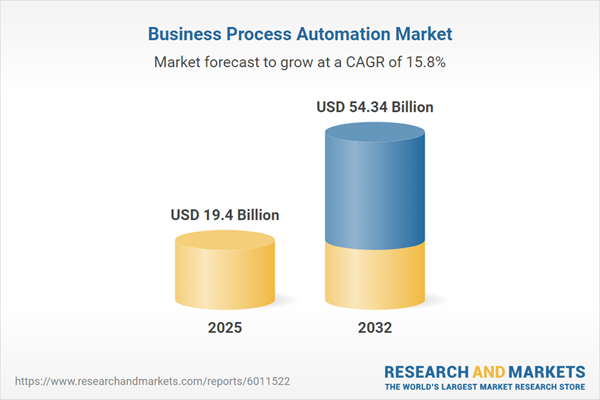Speak directly to the analyst to clarify any post sales queries you may have.
Business process automation is transforming how organizations adapt to evolving competitive and operational demands, streamlining workflows, enhancing efficiency, and reinforcing compliance across multiple industries. This market report provides senior leaders with the strategic insights needed to drive effective automation initiatives in a dynamic global environment.
Business Process Automation Market Snapshot
The Business Process Automation Market grew from USD 16.77 billion in 2024 to USD 19.40 billion in 2025. It is expected to continue growing at a CAGR of 15.83%, reaching USD 54.34 billion by 2032.
Accelerated by enterprise digitalization, cloud adoption, and artificial intelligence, this market is experiencing robust expansion as organizations prioritize modern automation frameworks to stay competitive. Shifting operational models, stringent regulatory compliance standards, and emerging technologies are equipping businesses to orchestrate data-driven, resilient, and scalable automation strategies for long-term growth.Scope & Segmentation of the Business Process Automation Market
- Component: Hardware, Services, Software
- Organization Size: Large Enterprises, Small and Medium Enterprises
- Deployment Type: Cloud, On Premises
- Application: Analytics & Monitoring, Document Management (Capture, Retrieval, Storage), Robotic Process Automation, Workflow Management
- Business Function: Customer Service, Finance and Accounting, Human Resources, Procurement and Supply Chain
- End User Industry: Banking and Finance, Healthcare, IT and Telecom, Manufacturing, Retail and E Commerce
- Regional Coverage: Americas (North America – United States, Canada, Mexico; Latin America – Brazil, Argentina, Chile, Colombia, Peru), Europe, Middle East & Africa (Europe – United Kingdom, Germany, France, Russia, Italy, Spain, Netherlands, Sweden, Poland, Switzerland; Middle East – United Arab Emirates, Saudi Arabia, Qatar, Turkey, Israel; Africa – South Africa, Nigeria, Egypt, Kenya), Asia-Pacific (China, India, Japan, Australia, South Korea, Indonesia, Thailand, Malaysia, Singapore, Taiwan)
- Company Coverage: UiPath Inc., Automation Anywhere Inc., Microsoft Corporation, Blue Prism Limited, NICE Ltd., Pegasystems Inc., International Business Machines Corporation, SAP SE, Kofax Inc., Appian Corporation
Key Takeaways for Senior Decision-Makers
- Integrating automation with digital infrastructure and cloud platforms is becoming critical for operational agility and resilience in response to evolving workforce and customer needs.
- AI-powered orchestration, low-code/no-code platforms, and intelligent document processing are enabling more streamlined, collaborative, and transparent process management across diverse functions.
- Heightened compliance requirements and regulatory shifts, such as new trade policies and tariffs, are prompting enterprises to reassess supplier diversification, localize operations, and refine strategic sourcing practices.
- Regional variations—driven by data sovereignty mandates, sectoral regulations, and government incentives—require locally optimized deployment and integration strategies.
- Partnership-driven innovation and merger activities among automation technology providers are shaping technology roadmaps and market differentiation.
- Investing in workforce training, governance models, and modular platforms supports scalable, sustainable automation adoption and continuous process optimization.
Tariff Impact on Supply Chains and Automation Costs
Recent United States tariffs are introducing significant challenges to hardware supply chains, with direct impacts on procurement strategies and cost structures. Many enterprises are shifting to longer-term supplier contracts, expanding sourcing regions, and advancing cloud-native solutions to overcome these pricing pressures. These adjustments underscore the need for dynamic sourcing models and cost management in technology investment planning.
Research Methodology & Data Sources
This study uses a combination of qualitative and quantitative research, including interviews with senior executives and process owners, structured surveys, and comprehensive analysis of industry reports, whitepapers, regulatory filings, and public disclosures. Key findings are validated through data triangulation, peer review, and expert workshops to ensure accuracy and relevance.
Why This Report Matters for Enterprise Leaders
- Provides a robust foundation for assessing value-based automation investments across functions, industries, and regions.
- Offers actionable, data-driven recommendations on optimizing process efficiency, compliance, and technology ROI.
- Enables informed strategic planning in response to regulatory shifts, supply chain pressures, and emerging technology trends.
Conclusion
This report delivers the clarity and direction needed to navigate the evolving business process automation landscape. Enterprise leaders are positioned to enhance operations, manage risk, and seize opportunities for sustainable growth through targeted automation strategies.
Additional Product Information:
- Purchase of this report includes 1 year online access with quarterly updates.
- This report can be updated on request. Please contact our Customer Experience team using the Ask a Question widget on our website.
Table of Contents
3. Executive Summary
4. Market Overview
7. Cumulative Impact of Artificial Intelligence 2025
Companies Mentioned
The companies profiled in this Business Process Automation market report include:- UiPath Inc.
- Automation Anywhere Inc.
- Microsoft Corporation
- Blue Prism Limited
- NICE Ltd.
- Pegasystems Inc.
- International Business Machines Corporation
- SAP SE
- Kofax Inc.
- Appian Corporation
Table Information
| Report Attribute | Details |
|---|---|
| No. of Pages | 183 |
| Published | October 2025 |
| Forecast Period | 2025 - 2032 |
| Estimated Market Value ( USD | $ 19.4 Billion |
| Forecasted Market Value ( USD | $ 54.34 Billion |
| Compound Annual Growth Rate | 15.8% |
| Regions Covered | Global |
| No. of Companies Mentioned | 11 |









